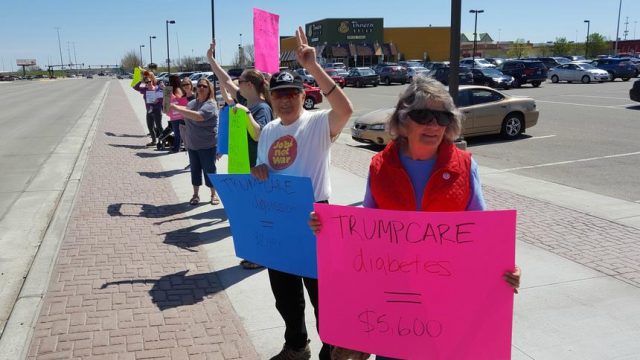Jon Godfread: Don’t Get Sucked Into False Claims and Overblown Statements in Health Care Debate

With the recent passage of the American Health Care Act (AHCA) by the U.S. House of Representatives, it is important to have an honest and truthful discussion regarding what the AHCA is and what it is not. But before we get into that, what does the health insurance marketplace look like in North Dakota?
There are a few different areas in which North Dakotans currently receive their health coverage – an employer, the government (Medicare, Medicaid or the VA) or the individual marketplace. Currently, 9-11 percent of North Dakotans do not have health insurance. Of the 89-91 percent of us who do have health insurance, roughly 68 percent have health insurance through an employer-sponsored health care plan, another 26 percent receive coverage through a government option, leaving 6 percent who use the individual marketplace. The AHCA mainly affects the six percent in the individual market place.
The government’s role in insurance and health care is to maintain public health and safety. It should ensure that the insurance plans offered for sale provide a baseline of coverage, emergency, epidemic, vaccinations and catastrophic care. It is the responsibility of the states and the private market to offer additional coverage thus tailoring plans to best fit our population’s needs and desires. The AHCA would allow states to apply for certain waivers from Obamacare mandates that are driving the enormous increase in health insurance costs and allow states to more appropriately define those benefits for their people. In order to apply for one of the waivers, North Dakota would need to utilize our state high-risk pool for patients with pre-existing conditions. By utilizing our high-risk pool, we can then move some of the higher cost patients out of the regular market, maintain their coverage and allow the general marketplace to respond.
[mks_pullquote align=”right” width=”300″ size=”24″ bg_color=”#ffffff” txt_color=”#000000″]There are states all across the country who have NO plans for sale in the individual marketplace. [/mks_pullquote]
Obamacare was premised upon the young and healthy purchasing health insurance in order to subsidize the market so that the sick could be guaranteed coverage. However, over the past six years, the young and healthy have not sufficiently engaged in the health care marketplace. I cannot blame them for this. As our young, healthy consumers analyze whether or not to purchase health insurance, the numbers are not adding up in favor of purchasing the insurance. Thus, costs have risen for everyone who has purchased health insurance. By utilizing high-risk pools, the state can continue to cover those people who have gained access to health insurance with a plan that has similar coverage to an Obamacare plan, while also removing their risk and the rising costs that result from having these individuals and their increased costs in the same pool as the general marketplace. As it stands now, a small percentage of our population is responsible for a majority of the health care costs in our state. By moving this population to a high-risk pool, we can give them the coverage they need without pricing out the rest of our population.
North Dakota is one of the few states in the U.S. that still has a high-risk pool. Our pool, known as the Comprehensive Health Association of North Dakota (CHAND), has for decades successfully provided quality coverage for North Dakotans who have pre-existing conditions. The AHCA appears to take a step in the right direction by increasing funding for these high-risk pools, however, it will be extremely important to ensure the high risk pools are adequately funded moving forward as underfunding them would be setting the AHCA up for failure.
In a letter I wrote to Congress this past January, I said, “You won’t find a bigger supporter of a prompt and speedy reform of the ACA than the Insurance Commissioner of North Dakota; however, I also understand the reality Congress is facing. The last thing America needs is another hastily-passed health care law without proper and prudent input from stakeholders across the country.” All of which is still true, but there are also realties we are facing as our current health care law is crumbling. There are states all across the country who have NO plans for sale in the individual marketplace. In fact, we don’t have to look far to find a state in crisis. Both Iowa and Oklahoma are currently facing a collapse of their individual markets. They are scrambling to find solutions and Congressional action returning authority to the states is the solution. We are at a point where doing nothing is no longer an option.
Finally, any discussion regarding health insurance must address the issue of the main cost-driver – the cost of receiving health care. Continuing to change the model of insurance is akin to rearranging the deck chairs on the Titanic. The reality is that the health care delivery model in this country needs to change. We should seek to incentivize those providers who are transparent regarding the specifics of charges for their services and procedures. In addition, enacting laws or policies that eliminate the abuses present within the Medicare and Medicaid programs would help reduce costs to taxpayers supporting these programs.
The AHCA is not perfect. Obamacare is crumbling and some action must be taken. In all likelihood, the bill that the Senate debates will be vastly different from the version recently passed by the House, and the compromise version that could ultimately pass will likely also be different. Now is not the time to get sucked into rhetoric, false claims and overblown statements. I hope all North Dakotans will remain engaged and well-educated as this process continues.




